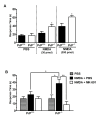Cellular prion protein protects from inflammatory and neuropathic pain
- PMID: 21843375
- PMCID: PMC3170224
- DOI: 10.1186/1744-8069-7-59
Cellular prion protein protects from inflammatory and neuropathic pain
Abstract
Cellular prion protein (PrPC) inhibits N-Methyl-D-Aspartate (NMDA) receptors. Since NMDA receptors play an important role in the transmission of pain signals in the dorsal horn of spinal cord, we thus wanted to determine if PrPC null mice show a reduced threshold for various pain behaviours.We compared nociceptive thresholds between wild type and PrPC null mice in models of inflammatory and neuropathic pain, in the presence and the absence of a NMDA receptor antagonist. 2-3 months old male PrPC null mice exhibited an MK-801 sensitive decrease in the paw withdrawal threshold in response both mechanical and thermal stimuli. PrPC null mice also exhibited significantly longer licking/biting time during both the first and second phases of formalin-induced inflammation of the paw, which was again prevented by treatment of the mice with MK-801, and responded more strongly to glutamate injection into the paw. Compared to wild type animals, PrPC null mice also exhibited a significantly greater nociceptive response (licking/biting) after intrathecal injection of NMDA. Sciatic nerve ligation resulted in MK-801 sensitive neuropathic pain in wild-type mice, but did not further augment the basal increase in pain behaviour observed in the null mice, suggesting that mice lacking PrPC may already be in a state of tonic central sensitization. Altogether, our data indicate that PrPC exerts a critical role in modulating nociceptive transmission at the spinal cord level, and fit with the concept of NMDA receptor hyperfunction in the absence of PrPC.
Figures




Similar articles
-
Role of the spinal cord NR2B-containing NMDA receptors in the development of neuropathic pain.Exp Neurol. 2009 Feb;215(2):298-307. doi: 10.1016/j.expneurol.2008.10.018. Epub 2008 Nov 12. Exp Neurol. 2009. PMID: 19046970
-
Differential effects of NMDA and group I mGluR antagonists on both nociception and spinal cord protein kinase C translocation in the formalin test and a model of neuropathic pain in rats.Pain. 2001 Oct;94(1):17-29. doi: 10.1016/S0304-3959(01)00337-2. Pain. 2001. PMID: 11576741
-
D-aspartate modulates nociceptive-specific neuron activity and pain threshold in inflammatory and neuropathic pain condition in mice.Biomed Res Int. 2015;2015:905906. doi: 10.1155/2015/905906. Epub 2015 Jan 5. Biomed Res Int. 2015. PMID: 25629055 Free PMC article.
-
Involvement of cellular prion protein in the nociceptive response in mice.Brain Res. 2007 Jun 2;1151:84-90. doi: 10.1016/j.brainres.2007.03.024. Epub 2007 Mar 13. Brain Res. 2007. PMID: 17433806
-
Contribution of the spinal cord BDNF to the development of neuropathic pain by activation of the NR2B-containing NMDA receptors in rats with spinal nerve ligation.Exp Neurol. 2010 Apr;222(2):256-66. doi: 10.1016/j.expneurol.2010.01.003. Epub 2010 Jan 14. Exp Neurol. 2010. PMID: 20079352
Cited by
-
Glutamate receptors function as scaffolds for the regulation of β-amyloid and cellular prion protein signaling complexes.Mol Brain. 2015 Mar 24;8:18. doi: 10.1186/s13041-015-0107-0. Mol Brain. 2015. PMID: 25888324 Free PMC article. Review.
-
The diverse roles of mononuclear phagocytes in prion disease pathogenesis.Prion. 2012 Apr-Jun;6(2):124-33. doi: 10.4161/pri.18853. Epub 2012 Apr 1. Prion. 2012. PMID: 22421209 Free PMC article. Review.
-
Synthesis and characterization of a disubstituted piperazine derivative with T-type channel blocking action and analgesic properties.Mol Pain. 2016 Apr 6;12:1744806916641678. doi: 10.1177/1744806916641678. Print 2016. Mol Pain. 2016. PMID: 27053601 Free PMC article.
-
Analgesic effect of a mixed T-type channel inhibitor/CB2 receptor agonist.Mol Pain. 2013 Jul 1;9:32. doi: 10.1186/1744-8069-9-32. Mol Pain. 2013. PMID: 23815854 Free PMC article.
-
Cellular prion protein (PrP(C)) and its role in stress responses.Int J Clin Exp Med. 2015 May 15;8(5):8042-50. eCollection 2015. Int J Clin Exp Med. 2015. PMID: 26221369 Free PMC article.
References
-
- Yaksh TL. Regulation of spinal nociceptive processing: where we went when we wandered onto the path marked by the gate. Pain. 1999;6:149–152. - PubMed
Publication types
MeSH terms
Substances
LinkOut - more resources
Full Text Sources
Other Literature Sources
Molecular Biology Databases

